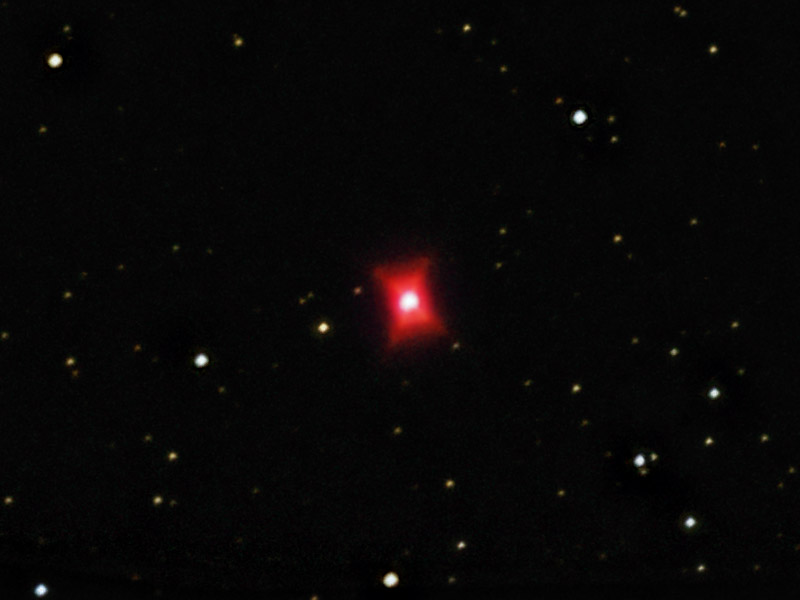Object name: REDDesignation(s): RED, RECTANGLE, The star is HD 44179 magnitude 8.85 about 1250 light years away. It is a post AGB star in the process of forming a proto-planetary nebula. I've run several planetary nebula but this is the first one in its early formative phase. These are formed as a star of similar mass as our sun runs out of fuel and contracts into a white dwarf. This final phase can cause the star to puff off its outer gas shell leaving only the inner core which then collapses into a white dwarf. This is a star that is in this short duration phase as it dies. Come back in a few thousand years and see if it was successful in forming such a planetary nebula. Why this forming gas shell would take on a nearly perfect rectangular shape is quite the mystery. Though the fact the star is really a close double star wrapped in dust envelop so thick we can't see the stars themselves, only the bright envelop they are in, may have something to do with the shape.
Without the earth's atmosphere screwing things up Hubble was able to get a really good view of this nebula.
The star is HD 44179 magnitude 8.85 about 1250 light years away. It is a post-AGB star in the process of forming a proto-planetary nebula. I've run several planetary nebulae but this is the first one in its early formative phase. These are formed as a star of similar mass as our sun runs out of fuel and contracts into a white dwarf. This final phase can cause the star to puff off its outer gas shell leaving only the inner core which then collapses into a white dwarf. This is a star that is in this short duration phase as it dies. Come back in a few thousand years and see if it was successful in forming such a planetary nebula. Why this forming gas shell would take on a nearly perfect rectangular shape is quite the mystery. Though the fact the star is really a close double star wrapped in dust envelop so thick we can't see the stars themselves, only the bright envelop they are in, may have something to do with the shape.
Without the earth's atmosphere screwing things up, Hubble was able to get a really good view of this nebula.
http://hubblesite.org/news_release/news/2004-11
At -10.6 it is down in my poor seeing.
In order not to lose the nebula to the star I had to 117 30 second images. Since the star is very blue (B8) I used the red images to make a pseudo luminosity image which was then colored by the RGB image made from all 117 images. Why is it red? Here's one possible answer.
http://www.space.com/scienceastronomy/070406_red_rectangle.html
One problem with this answer is that there's also what is known as the Red Square Nebula. It too is around a Post AGB star but is so red it is visible only in the infrared. Otherwise, it appears virtually the same (but more square) as the Red Rectangle.
http://www.abc.net.au/science/news/stories/2007/1895422.htm?space
My image is at 0.5" per pixel which really shows distortions from poor seeing.
14" LX200R @ f/10, R=34x30" G=42x30" B=41x30"
http://hubblesite.org/news_release/news/2004-11
At -10.6 it is down in my poor seeing.
In order not to lose the nebula to the star I had to 117 30 second images. Since the star is very blue (B8) I used the red images to make a pseudo luminosity image which was then colored by the RGB image made from all 117 images. Why is it red? Here's one possible answer.
http://www.space.com/scienceastronomy/070406_red_rectangle.html
One problem with this answer is that there's also what is known as the Red Square Nebula. It too is around a Post AGB star but is so red it is visible only in the infra red. Otherwise it appears virtually the same (but more square) as the Red Rectangle.
http://www.abc.net.au/science/news/stories/2007/1895422.htm?space
My image is at 0.5" per pixel which really shows distortions from poor seeing.
14" LX200R @ f/10, R=34x30" G=42x30" B=41x30" | | 